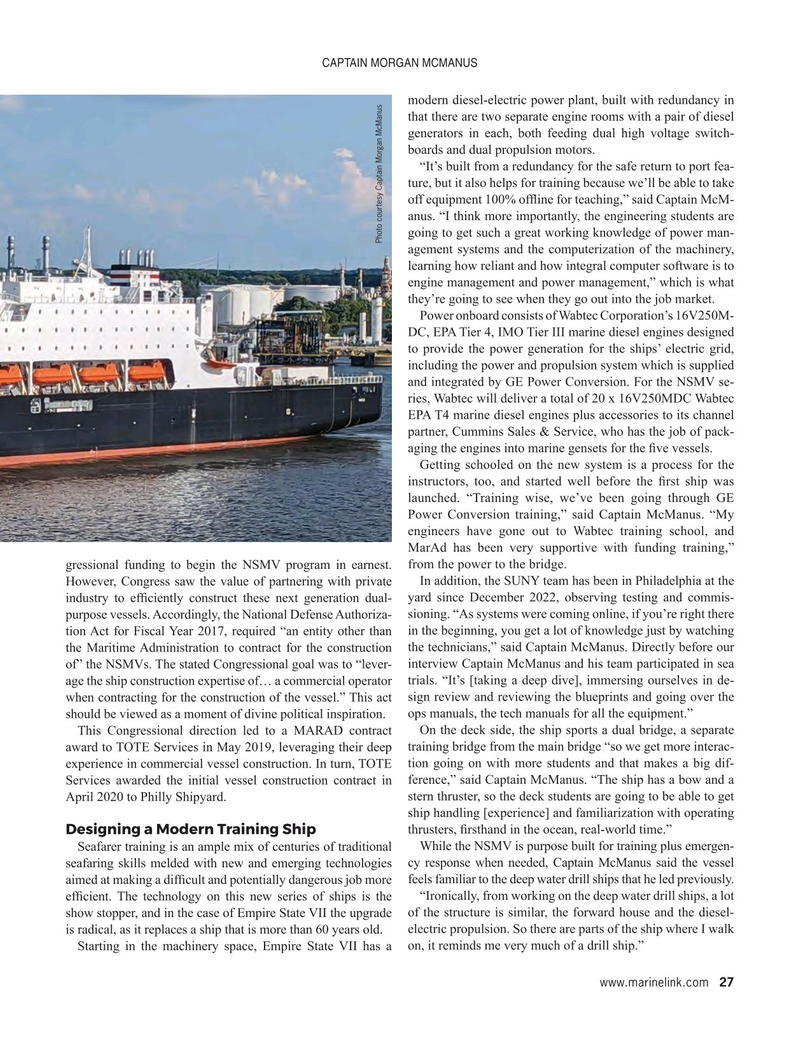
Page 27: of Maritime Reporter Magazine (September 2023)
Marine Design Edition
Read this page in Pdf, Flash or Html5 edition of September 2023 Maritime Reporter Magazine
CAPTAIN MORGAN MCMANUS modern diesel-electric power plant, built with redundancy in that there are two separate engine rooms with a pair of diesel generators in each, both feeding dual high voltage switch- boards and dual propulsion motors.
“It’s built from a redundancy for the safe return to port fea- ture, but it also helps for training because we’ll be able to take off equipment 100% of? ine for teaching,” said Captain McM- anus. “I think more importantly, the engineering students are going to get such a great working knowledge of power man-
Photo courtesy Captain Morgan McManus agement systems and the computerization of the machinery, learning how reliant and how integral computer software is to engine management and power management,” which is what they’re going to see when they go out into the job market.
Power onboard consists of Wabtec Corporation’s 16V250M-
DC, EPA Tier 4, IMO Tier III marine diesel engines designed to provide the power generation for the ships’ electric grid, including the power and propulsion system which is supplied and integrated by GE Power Conversion. For the NSMV se- ries, Wabtec will deliver a total of 20 x 16V250MDC Wabtec
EPA T4 marine diesel engines plus accessories to its channel partner, Cummins Sales & Service, who has the job of pack- aging the engines into marine gensets for the ? ve vessels.
Getting schooled on the new system is a process for the instructors, too, and started well before the ? rst ship was launched. “Training wise, we’ve been going through GE
Power Conversion training,” said Captain McManus. “My engineers have gone out to Wabtec training school, and
MarAd has been very supportive with funding training,” gressional funding to begin the NSMV program in earnest. from the power to the bridge.
However, Congress saw the value of partnering with private In addition, the SUNY team has been in Philadelphia at the industry to ef? ciently construct these next generation dual- yard since December 2022, observing testing and commis- purpose vessels. Accordingly, the National Defense Authoriza- sioning. “As systems were coming online, if you’re right there tion Act for Fiscal Year 2017, required “an entity other than in the beginning, you get a lot of knowledge just by watching the Maritime Administration to contract for the construction the technicians,” said Captain McManus. Directly before our of” the NSMVs. The stated Congressional goal was to “lever- interview Captain McManus and his team participated in sea age the ship construction expertise of… a commercial operator trials. “It’s [taking a deep dive], immersing ourselves in de- when contracting for the construction of the vessel.” This act sign review and reviewing the blueprints and going over the should be viewed as a moment of divine political inspiration. ops manuals, the tech manuals for all the equipment.”
This Congressional direction led to a MARAD contract On the deck side, the ship sports a dual bridge, a separate award to TOTE Services in May 2019, leveraging their deep training bridge from the main bridge “so we get more interac- experience in commercial vessel construction. In turn, TOTE tion going on with more students and that makes a big dif-
Services awarded the initial vessel construction contract in ference,” said Captain McManus. “The ship has a bow and a
April 2020 to Philly Shipyard. stern thruster, so the deck students are going to be able to get ship handling [experience] and familiarization with operating thrusters, ? rsthand in the ocean, real-world time.”
Designing a Modern Training Ship
Seafarer training is an ample mix of centuries of traditional While the NSMV is purpose built for training plus emergen- seafaring skills melded with new and emerging technologies cy response when needed, Captain McManus said the vessel aimed at making a dif? cult and potentially dangerous job more feels familiar to the deep water drill ships that he led previously. ef? cient. The technology on this new series of ships is the “Ironically, from working on the deep water drill ships, a lot show stopper, and in the case of Empire State VII the upgrade of the structure is similar, the forward house and the diesel- is radical, as it replaces a ship that is more than 60 years old. electric propulsion. So there are parts of the ship where I walk
Starting in the machinery space, Empire State VII has a on, it reminds me very much of a drill ship.” www.marinelink.com 27
MR #9 (18-33).indd 27 9/6/2023 5:18:03 PM

 26
26

 28
28
